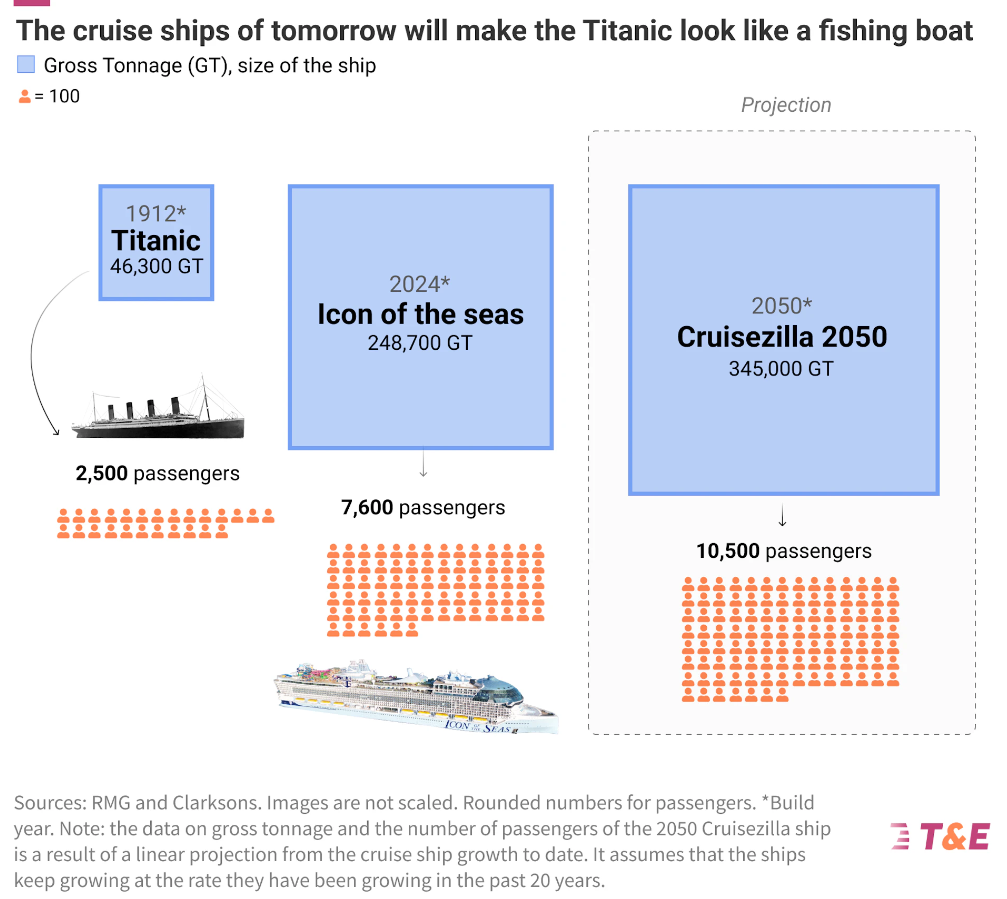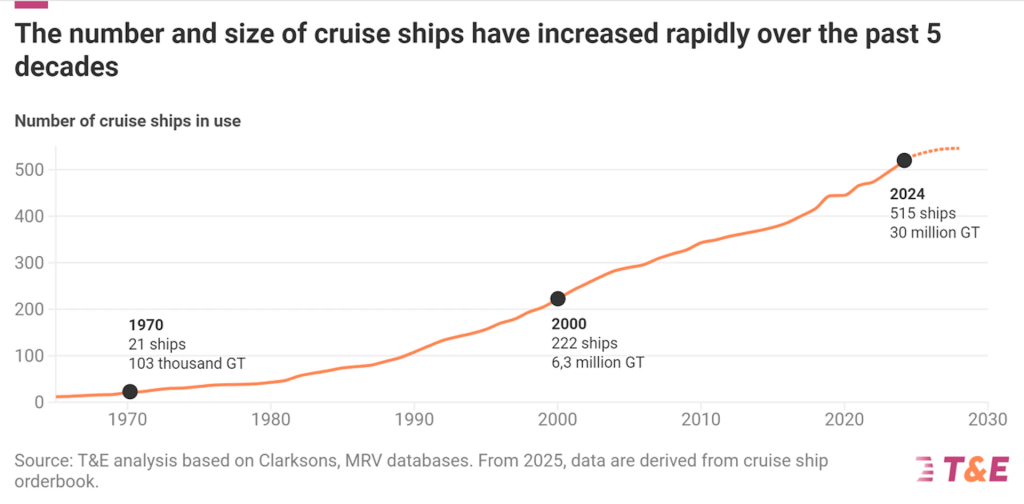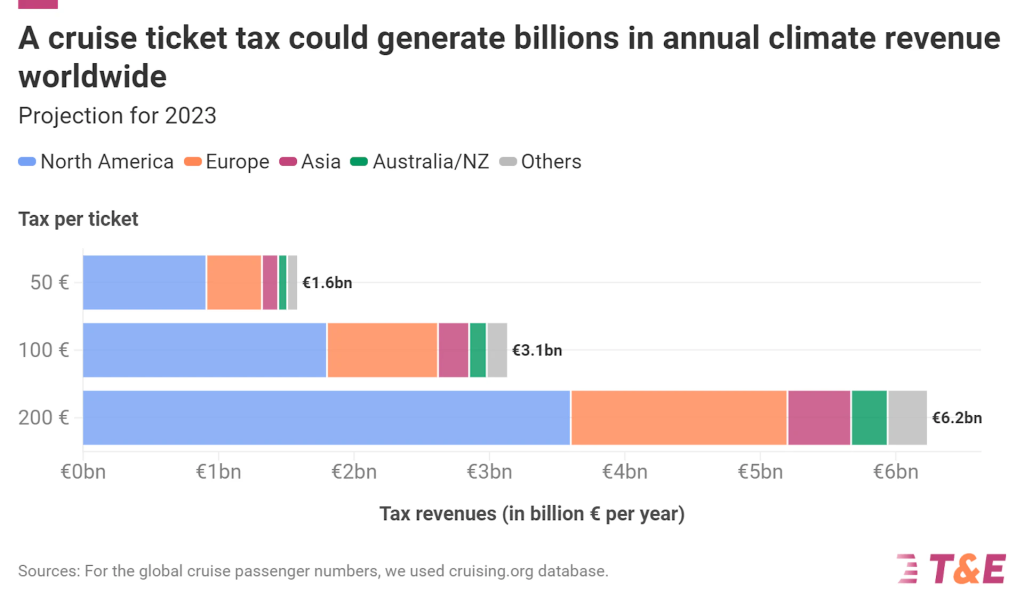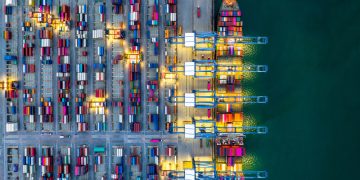Today’s biggest cruise ships are twice as big as they were in 2000, a new Transport & Environment (T&E) report shows.
According to T&E, if they continue to grow at this rate, the biggest cruise ships in 2050 could amount to a staggering 345,000 gross tonnage, making them almost eight times bigger than the Titanic. The rapid growth in cruise holidays and increase in cruise ship sizes comes at a significant environmental cost, says T&E.
The global cruise industry has boomed over the past half a century, with the number of ships rising twentyfold from only 21 in 1970 to 515 today. A combination of more and bigger cruise ships means that CO2 emissions from cruise ships in Europe were nearly 20% higher in 2022 than they were in 2019 before the pandemic.
Today’s cruisezillas make the Titanic look like a small fishing boat. How much bigger can these giants get? The cruise business is the fastest growing tourism sector and its emissions are quickly getting out of control.
… said Inesa Ulichina, sustainable shipping officer at T&E
 In the face of backlash, many cruise operators are switching to liquefied natural gas (LNG) as an alternative to traditional shipping fuels like heavy fuel oil. LNG-powered ships make up 38% of global cruise ship orders today. While LNG emits less pollutants and CO2 when burned, it releases methane, a greenhouse gas over 80 times more potent than CO2, T&E notes.
In the face of backlash, many cruise operators are switching to liquefied natural gas (LNG) as an alternative to traditional shipping fuels like heavy fuel oil. LNG-powered ships make up 38% of global cruise ship orders today. While LNG emits less pollutants and CO2 when burned, it releases methane, a greenhouse gas over 80 times more potent than CO2, T&E notes.
Inesa Ulichina, added: “The only green and scalable solution for decarbonising maritime activities is e-fuels. Cruising is a luxury business and operators must take responsibility for their climate impact. If they want to avoid becoming increasingly unwanted visitors, they must clean up their act.”

Green e-fuels could power almost 4% of European shipping in 2030, a recent T&E study shows. The limited availability of e-fuels and their bunkering infrastructure should be less of an issue for the cruise ships, says T&E, as they sail on the same routes with clear schedules, making their fuel refuelling needs and timings predictable and relatively easy to plan.
It can also be financially beneficial for cruise operators to switch to green fuels, the latest study shows. Due to the EU’s carbon price on ships which took effect from the beginning of this year, and progressively increasing FuelEU Maritime penalties for using the dirtiest shipping fuels from 2025, sailing only on fossil fuel will become 13% more expensive than blending 4% of e-methanol into the fuel mix in 2030. The cost increase when sailing on fossil fuel compared to blending e-fuels could reach more than 30% in 2040 and over 80% in 2050.
To accelerate cruise ship decarbonisation and contribute to the EU’s and global climate goals, T&E makes the following policy recommendations:
- Put cruise ships at the forefront of shipping decarbonisation by introducing faster and more stringent climate requirements compared to the rest of the fleet. This includes an earlier life-cycle decarbonisation deadline, connection to shore-side electricity at anchorage, and a larger share of e-fuels used onboard cruise ships. Cruise ships spend considerably more time in ports than other ship types and pose immediate health risks to the human population and nature. Given their luxury status and extensive greenwashing practices, cruise companies should be required to lead shipping’s decarbonisation efforts and deliver on their green claims.
- Explore implementing a tax on cruise tickets to raise additional climate finance without burdening the general public. Cruises are a luxury form of entertainment currently exempt from many corporate and consumer taxes applied to other transportation modes. Such a tax could generate billions in revenues globally, which could be used to facilitate the energy transition, especially in developing and least developed countries.
- Limit cruise ship traffic in areas vulnerable to marine and air pollution and establish no-cruise zones in the most fragile sites. Where cruise traffic remains permissible, only ships meeting the highest environmental standards and appropriate size should be allowed to operate.
- Ensure transparency and reduce cruise greenwashing by requiring full disclosure of emissions from cruise ships, verified and accessible through public databases. This would help debunk cruise greenwashing claims and educate consumers by, for example, showing the negative climate impact of fossil LNG.
- Address methane emissions from cruise ships by ensuring that EU legislation correctly reflects the level of methane slippage. This can be achieved by revising the methane slip factor set by the FuelEU Maritime Regulation to accurately represent the actual level of methane emissions that escape from LNG engines.
 Cruise ships are currently exempt from fuel duties, corporate taxes and most of the consumer taxes that other modes of transport are subject to. A €50 ticket tax on a typical cruise ticket would bring in €1.6 billion globally, according to the analysis. This could provide crucial climate finance and ensure that luxury forms of travel are taxed, says T&E.
Cruise ships are currently exempt from fuel duties, corporate taxes and most of the consumer taxes that other modes of transport are subject to. A €50 ticket tax on a typical cruise ticket would bring in €1.6 billion globally, according to the analysis. This could provide crucial climate finance and ensure that luxury forms of travel are taxed, says T&E.

































































